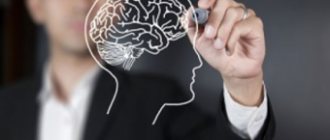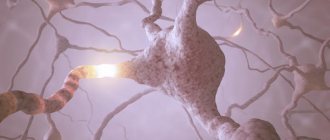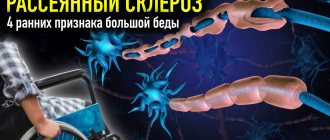According to many doctors, this disease is very rare. However, most likely, as they say, “there are no healthy people, there are only those who have not been thoroughly examined.” Many people live their entire lives with this disease without even knowing about its existence. This is because it is very difficult to identify. At least until several symptoms appear at once. For this reason, doctors call MS a chameleon disease. When the myelin sheath is destroyed, the affected parts of the brain no longer function properly. Accordingly, the functioning of those organs for which the affected parts of the brain were responsible is disrupted.
Development mechanism
Sclerosis is a chronic degenerative disease of the central nervous system, in which the speed and quality of impulse transmission slows down significantly.
Do not confuse scientific terminology with the layman’s understanding of the essence of the phenomenon.
The concept of “sclerosis” has nothing to do with senile memory problems. This word means an area of scarring, replacement of functionally active tissue with a “plug” that simply takes up space.
As for “absent-mindedness,” we are talking about the multiplicity of foci in the brain and spinal cord, their uneven distribution in the nervous tissues.
The disorder is based on the destruction of the myelin sheath of the conductive pathways (axons). In more detail, it is this outer layer that prevents the nerve signal from moving incorrectly. To better understand, just imagine an electrical cable without insulation.
Once the pathological process begins, the signal cannot move through the network.
The result is first partial and then complete loss of functions of individual brain structures. Vision, hearing, sensory organs, and motor activity are affected. There may be a complex of negative manifestations and consequences.
Destruction of the myelin sheath (demyelination) occurs as a result of autoimmune inflammation. That is, the cells of their own immunity attack the myelin. This is the basis of the pathological condition.
Destruction of myelin is accompanied by sclerosis of the affected area. In other words, overgrowth with scar tissue, in the form of a plaque, which does not perform any functions, but replaces the myelin sheath.
If we talk about the origin of the violation, any negative factor can serve as a trigger.
The mechanisms of development of MS will be as follows:
- Hormonal imbalances. Disturbances of the normal background of specific substances. Any organ of the endocrine system can be involved: from the pituitary gland to the adrenal glands.
- Mechanical damage to the brain or spinal cord. When receiving injuries: bruises, spinal fractures, head injuries and other negative conditions.
- Exposure to ionizing radiation on the body. Radiation.
- Stress factors. The exact role is still difficult to establish.
- Immunity disorders. Against the background of previous infections or other inflammatory phenomena.
- Genetic predisposition.
The hereditary factor plays perhaps a key role in the development of the pathological process. Patients descended from ancestors with multiple sclerosis are 3-4 times more likely to encounter the disease than healthy people without a history of multiple sclerosis.
Apparently, the main reason, again, is the genetically programmed features of the immune system. Thus, multiple sclerosis is a chronic autoimmune disease.
This also includes poor nutrition, living in environmentally unfavorable areas and regions of the planet, constant exposure to high doses of ultraviolet radiation on the body, as well as a lack of sunlight. The list goes on and on.
Scientists agree that the etiology of the disease is based on the interaction of external and internal factors.
How to live with multiple sclerosis?
Step one : find out everything about your illness. Find all the information about the causes, symptoms, treatment methods, effective and new. Read and rethink. Try it on for yourself. And accept your diagnosis not as a sentence, not as a punishment, but only as a test of strength. Consider that you are passing the most important exam in your life - for the right to live. It is important to know what is strictly prohibited for this disease. A hot bath, hot food, hot weather are things that are not allowed under any circumstances if you have MS. There is even a hot bath test, which is, to put it mildly, a cruel test because it causes a sharp aggravation. Stress and viral infections also contribute to a new round of disease. You must learn to avoid all of the above.
Step two : never give up traditional medicine. It is better to try all methods from the folk arsenal in parallel or, in some cases, after drug courses of treatment. If you can get an expensive course for free, as part of some health or social welfare projects, go for it. Treatment for MS usually comes down to heavy doses of nootropics, vasodilating and restorative therapy, and hormonal therapy. The latter is fraught with a lot of complications and side effects in the presence of a fairly stable remitting effect. Treatment with immunomodulators is usually used at the initial stage of the disease. Reaferon, betaferon, Copaxone are considered almost a panacea for MS. I can say that it is insanely expensive, difficult to bear and does not always help everyone. In Russia and Ukraine, Copaxone is issued free of charge if you have disability groups 1 and 2. Copaxone, the newest of the line of immunomodulators, is simply not available in Kazakhstan. Injection betaferon is an outdated analogue. The queue for free pick-up is moving at a snail's pace. An effective remedy that can stop the progression of the disease is a stem cell transplant. But, alas, this is not affordable for everyone. Among the folk remedies, we can name chinstrap, which is widely used in the practice of treating MS.
Step three : cleansing the physical body. There are a lot of techniques that have been tested before you on thousands of people. You can cleanse yourself with the help of dietary supplements or with the help of one of the author’s wellness programs, for example, Semyonova or Malakhov. Their books are sold in any bookstore and have long gained a reputation for being proven and effective.
Step four : cleansing on the mental level. Forgive and let go of everything and everyone that led to stress and resentment in that life when the disease had not yet overtaken you. Forgiveness meditations have been developed by many modern positivist psychologists. Get acquainted with the system of Sviyash, Norbekov and others and find an acceptable path for yourself. I would recommend starting with Louise Hay's books. Illness often becomes the beginning of rethinking the attitude towards oneself, the world, and people, the beginning of the path to light and spirituality. It doesn’t matter who will help you with this: the church, a psychotherapist or an esotericist. Meditate, chant mantras, read prayers, ask and you will be heard.
Step five : physical activity. If you can take two steps near the bed, take them. If you can move your fingers, move them. Two steps in a few days or months can become a thousand, and naughty hands will become stronger. Gymnastics, any exercise, even the most basic, helps to accumulate energy. The bodyflex system developed by Greer Childers helps well with MS. It does not require much effort and is suitable even for very weakened patients. Breathing and stretching exercises are exactly what MS requires because muscle weakness and breathing problems are common symptoms.
Step six : great power of thought and positive attitude. Even while lying in bed, you can work on your healing, imagine yourself healthy, full of strength, i.e. visualize. You can read Sytin’s sentiments, or you can write your own, based on your own symptoms. You can recite Louise Hay's affirmations. Or create your own. Step seven : establish nutrition. Many foods will have to be excluded from the diet: sausages, ketchup, deep-fried food, cakes, ice cream. You can and should eat fatty fish, lean meat, preferably chicken, eggs, cottage cheese, low-fat cheese, legumes: beans, peas, beans, lentils, vegetables and fruits, chocolate, honey, low-fat dairy products, liver. Drink 1.5−2 liters of water per day. Better than thawed or protium. It is indispensable for chronic fatigue that accompanies MS; it charges you with vivacity and energy. Step eight : do not refuse feasible work. Yes, many people with MS are unable to go to work. But you can also work at home. This makes it possible to feel needed and, albeit small, but an increase to those pennies with which the caring state has blessed you. What can you do at home? Yes, anything: sort mail, glue boxes, answer calls, do something to order. The main thing is not to despair and remember everything that you know and are capable of doing under the current conditions.
Step nine : communicate with people. Don’t withdraw into yourself, make contact with others, take an interest in everything that happens around you. For many patients, the Internet becomes a window to the world and makes it possible to feel not alone. And you shouldn’t allow yourself to discuss and savor the details of your illness, this will only charge it with additional energy.
Step ten : do everything that you are able to do on your own, without hoping for outside help, through “I can’t” and “I don’t want.”
Remember that there are no incurable diseases. And multiple sclerosis is no exception. You can first learn to coexist with it, and then drive it into a corner, because you are a spirit in a mortal body, and the power of the human spirit works miracles.
Tags: nervous system, disabled people, diseases, brain, treatment, multiple sclerosis
Classification
The pathological process is divided according to the nature of the disease. There are 4 types of the disorder.
Recurrent
The relapsing form of multiple sclerosis is the most common. As the name suggests, it is characterized by alternating periods of recovery of brain function with moments of exacerbation.
It is difficult to say how often relapses occur. On average, remission lasts up to several months and even years. A very sluggish course of the pathological process is possible.
In the relapsing-remitting variant of multiple sclerosis, nerve tissue is destroyed only during exacerbations. Then everything returns to normal. The deviation stops in development and even regresses without outside help.
The prognosis for relapsing-remitting sclerosis detected at an early stage is positive.
Primary progressive variety
It begins unnoticed, proceeds very quietly and gradually destroys the patient’s nerve tissue. The person does not notice the development of the pathological process.
A characteristic clinical picture is revealed when time has already passed for the effectiveness of treatment. All that remains is to fight the symptoms and somehow improve the quality of life of the sufferer.
A characteristic feature of this form is the absence of remissions and a continuous course.
Secondary progressive variety
It begins as a recurrent pathological process. After several months or years, the disease changes the nature of its development and flows continuously, destroying the patient’s nerve tissue.
High-quality recovery is possible only at a time when there are no critical deviations and constant progression yet.
The only way to detect multiple sclerosis is to have neurological exams every year. If a person is at risk, then every 6 months.
Progressive-remitting variety
Occurs in approximately 5% of the total number of clinical cases.
Starts slow. Then, within 2-3 months, it begins to destroy the central nervous system at a galloping pace.
It doesn’t go away, doesn’t stop, and certainly doesn’t regress. Very difficult to treat. For unknown reasons, it occurs mainly in children and patients after serious illnesses.
It is necessary to recognize multiple sclerosis in the first 6-12 months, before degenerative processes reach a peak, when it is already difficult or impossible to help. Therapy continues throughout life.
Symptomatic therapy
Hormones are the drugs of choice for diseases with an immune mechanism of development. Curing in this way is problematic, but you can significantly slow down or even stop the course of multiple sclerosis and restore lost functions.
The administration of high doses of hormones from the group of glucocorticosteroids in a short course is called “Pulse therapy”. .
Treatment regimen: Methylprednisolone in an amount of 1-2 grams is prescribed for 5-6 days or prednisolone 1.5 mg per kilogram of body weight per day, in the morning in 1-2 doses with 4 hour intervals, every other day or daily (for the course of treatment 1000 mg).
After ten days of therapy, the maximum dose is reduced by 5 mg every 2 days. The general course of treatment lasts 6 weeks.
If the optic nerve is damaged, drugs are injected into the retrobulbar fatty tissue behind the eye. At the end of the therapy, injections with adenocorticotropic hormone are prescribed.
Hemosorption and plasmapheresis for multiple sclerosis are carried out in the case of an acute course of the disease that threatens human life.
To combat exacerbations of
relapsing-remitting form of MS
The achievements of scientists in immunomodulation are used. Remedies used to gently and naturally activate the immune system reduce the likelihood of multiple sclerosis relapse by 1/3.
Among the drugs used for this purpose are betaferon and rebif. The drugs are prescribed to young patients with less than 2 exacerbations over the past 2 years.
During an exacerbation of the disease, several methods of combating the disease are distinguished.
Symptoms
The clinical picture depends on the form of the disorder, its severity, as well as the location of the foci of demyelination.
While the degree of damage is minimal, the functions of the altered neurons are taken over by healthy nerve tissue. This is how compensation for the pathological condition is achieved.
Then, the disease manifests itself with obvious but nonspecific signs.
The following manifestations are found:
- Dizziness. It occurs spontaneously, for no apparent reason. May cause falls and injury. In the same way, without action from the outside, it passes and is eliminated.
- Vomit. One-time. Regardless of food intake. Including on a completely empty stomach.
- Unsteadiness of gait and loss of coordination are signs that can be used to suspect multiple sclerosis at an early stage. It becomes simply impossible to walk in a straight line.
Caution:
The symptom may subside or persist before starting therapy. Until the methods for correcting the pathological process take effect.
- Nystagmus. Rhythmic eye movements left and right without the patient's volitional effort. This is the result of a malfunction of the cranial nerves. The symptom goes away as quickly as it started.
Then, once the disease reaches a certain degree of “maturity,” symptoms of multiple sclerosis include neurological deficits and mental disorders.
Here are some possible manifestations of the disorder:
- Loss of vision. First partial, in the form of scotoma. Blind spots that look like black barriers in the field of vision.
Then, as the disease progresses, anything can happen. Including complete loss of the ability to see.
But the development of such a critical complication usually requires more than a year of constant progression of the disease.
- Hearing disorders. Problems with speech perception and other noise stimuli. This is a characteristic feature of multiple sclerosis, tumors, inflammatory processes, and circulatory disorders. It is impossible to distinguish between diagnoses by eye. A special examination using instrumental methods is required.
- A typical symptom of multiple sclerosis is problems with diction and speech. At first, a person mints phrases and individual sounds too much. Then the reprimand suffers due to partial paresis of the facial muscles responsible for articulation.
Then a mental component is added, the patient begins to get confused in lexical means. There is a total loss of the ability to express oneself normally.
But this is a sign of an advanced stage of the pathological process. It shouldn't be brought to that point.
- Movement disorders. Ability to walk independently. There is marked weakness of the muscles of the limbs. Patients are forced to move with a cane. Then, if nothing is done, they are transferred to a wheelchair.
The same outcome is possible with resistant forms of multiple sclerosis, which do not respond to normal treatment.
- Hyperkinesis. Excessive muscle mobility. A type of seizure. Spontaneous muscle twitching is observed. The patient does not control these phenomena. They cause a lot of discomfort, especially at night. When a person is trying to sleep.
- Tremor. Trembling of the tips, fingers, chin, head. Especially when intending to make voluntary movements. For example, when turning to the side, straightening your arms.
- Paresis. Manifestation of an advanced form of the pathological process. Partial loss of the ability to move and feel. Usually the lower limbs or structures on one side are affected. Half body. It all depends on the exact source of the nerve conduction disorder.
- Paralysis. Complete loss of tissue sensitivity and ability to move. The disorder may affect the arms, legs, or all extremities of the body.
- Mood disorders. The first signs of multiple sclerosis are non-physical in nature, including depression, sudden changes in emotional background, irritability, and unmotivated aggression. Gradually, the manifestations of the disease will only intensify.
- Behavioral disorders. Inadequacy.
A little later, the cognitive sphere is also involved in the disorder. Intelligence decreases, personality begins to degrade.
At the same time, you need to understand that the list of symptoms for a particular patient will differ from the theoretical calculation. In one person, motor impairments predominate, in another, visual impairments predominate, and so on.
Neurological deficit is far from a death sentence. Pathology can and should be fought.
Early symptoms of multiple sclerosis include mild changes in the functioning of the visual and auditory analyzers, muscle weakness, and coordination disorders. You need to navigate them.
At the first suspicious signs, it makes sense to consult a doctor.
Symptoms
The first signs of multiple sclerosis are nonspecific and often go unnoticed by both the patient and the doctor. In most patients, the onset of the disease is manifested by symptoms of pathology in one system, and later others become involved.
Throughout the disease, exacerbations alternate with periods of complete or relative well-being. The first signs of multiple sclerosis include symptoms such as blurred vision, urinary retention, loss of coordination when walking, and even itchy skin.
It is worth dwelling in more detail on the possible symptoms of the onset of multiple sclerosis.
Damage to cranial nerves
There are typical signs of multiple sclerosis and atypical, rare ones, which, however, should not be forgotten.
Usually, one patient simultaneously exhibits signs of damage to different functional systems (due to the dispersion of the damage).
Typical manifestations
They represent a display of damage to the pathways of the nervous system. These are the so-called “classic” symptoms of multiple sclerosis.
Symptomatic treatment for patients with multiple sclerosis is selected in accordance with the clinical manifestations:
- For central paresis, muscle relaxants are prescribed to reduce increased muscle tone.
- Physiotherapy for the disease includes exchange plasmapheresis, acupuncture, stimulation of muscle biopotentials with the Myoton apparatus.
- Acupressure for multiple sclerosis is indicated for muscle twitching and cramps. The combination of physiotherapy and massage significantly facilitates the transmission of impulses along neuromuscular fibers, has a beneficial effect on metabolism, and reduces the manifestation of symptoms associated with multiple sclerosis.
After the destruction of the myelin sheath, the transmission of nerve impulses is disrupted. Demyelination can form anywhere, resulting in neurological disorders.
During the illness, stages of exacerbation alternate with stages of remission. If the disease is discovered for the first time, then neurological problems may not be visible.
Multiple sclerosis is an autoimmune disease, the distinctive feature of which is specific malfunctions in the functioning of the defense system.
Most often, this disease affects young people: the bulk of diagnosed cases (70%) are from 18 to 35 years old, 30% of cases are aged from 12 to 18 and after 40 years.
The body begins to perceive some of its own tissues as foreign objects and tries with all its might to get rid of them.
The first place to be attacked by antibodies is the myelin sheath, which is the outer layer of most nerve fibers. Antibodies cause the destruction of myelin, which is why the nerve fiber itself loses its sheath and becomes exposed.
It is at this moment that the patient may notice the first symptoms of the disease. For some time, the nerves will still fulfill their purpose, but without the myelin sheath, the destruction of the fibers themselves will begin.
At the stage of myelin destruction, the process can still be, if not reversed, then at least controlled. Nerve destruction is absolutely irreversible.
At the stage of disintegration of the myelin sheath, when the body partially restores it on its own, the symptoms of the disease either disappear or reappear.
Once the disease affects the fibers themselves, the patient will suffer from multiple sclerosis for the rest of his life.
Causes
Factors in the development of the disease are nonspecific. There are no triggers that specifically cause multiple sclerosis. Here are just a few possible provocateurs:
- Poor nutrition. High levels of animal fats and alcohol in the diet are associated with an increased risk.
- Past infections. Bacterial or viral. After any septic process, the development of the disease is possible. No one can tell you the exact probability. The only way to protect yourself from negative consequences is to treat the infection in time. Plus, it would be a good idea to strengthen your immune system after recovery.
- Stress. Mental stress. Increases the likelihood of a disorder, but does not directly cause it.
- Heredity. The genetic factor is considered one of the main ones. Therefore, patients with a complicated medical history need to be checked by a neurologist every six months. In order to catch the pathological process in time and begin to treat it at an early stage.
- Radiation. Ionizing radiation has an extremely negative effect on nerve tissue. Possible tumors, areas of demyelination, whatever.
- Environmentally unfavorable situation. With a high degree of air, soil, and water pollution.
- Injuries. Damage to the brain (including common concussions), spine. How soon the phenomenon will affect the body and whether it will happen at all - no one can determine in advance.
But such patients are also at increased risk. You need to have a preventative check every 6 months.
- Hormonal imbalances. Disorders of the pituitary gland, adrenal glands, thyroid gland, pancreas, reproductive structures. Anything can happen.
- Smoking. Nicotine consumption increases the likelihood of developing the disease by approximately 30-40%. Doctors' estimates vary.
Multiple sclerosis is provoked by autoimmune inflammation of brain structures at the micro level. It is in this context that the problem must be considered.
Multiple sclerosis: what is possible and what is not?
People with a confirmed diagnosis often wonder what not to do with multiple sclerosis.
There are a number of general rules and recommendations, which we will discuss below, but you should only listen to your feelings and the words of the attending physician, who is well aware of the individual course of the disease.
Prohibited:
• fast, incl. eat inadequately while following a diet; • experience excessive physical and emotional stress, including at work;
• visit saunas, hammams, baths, beaches, take hot baths;
• deplete the body from lack of sleep; • get sick - when visiting places with large crowds of people, it is better to use a mask, and also take vitamin complexes to maintain a healthy immune system;
• take certain medications (see below).
What should you not eat if you have multiple sclerosis?
In MS, special attention is paid to proper nutrition (frequency of meals, calorie content, balance, intake of vitamins, etc.). A diet for patients involves excluding from the diet foods that can activate a chain of autoimmune processes, which ultimately lead to demyelination (destruction of the myelin sheath of nerve endings in the central nervous system).
Products recommended for daily consumption:
1. Fig.2. Buckwheat.3. Millet.4. Corn grits.5. Hazelnut.6. Almonds.7. Walnut.8. Pine nuts.9. Turkey or chicken breast (without skin).10. Rye bread (small amount).11. Berries.12. Fruits.13.
Vegetables.14. Sea kale.15. Sea fish.16. Mussels.17. Shrimp.18. Crab meat.19. Lettuce leaves.20. Parsley.21. Leeks.22. Celery.23. Dill.24. Vegetable oil (cold pressed).
25. Vegetable, fruit or combined fresh juice.
(recommended to be completely avoided):
• dairy products, especially with a fat content of more than 1 unit;• egg yolks;• lard;• red meat;• sausages;• products containing brewer's yeast;• fast food;• semi-finished products;• cereals containing gluten (barley, rye, wheat, etc.);• drinks containing sugar;
• alcohol;
• caffeine-containing drinks; • soda; • animal oil and other oily bases containing unsaturated fatty acids; • legumes; • potatoes;
• baked goods, chocolate, candies and other products that contain a lot of sugar.
Why can't you eat sweets if you have multiple sclerosis?
Sweet products often contain so-called “hidden” fats (heavy molecules of animal and industrial origin). It is these ingredients that can provoke the progression of R.S., deterioration of the general condition, and exacerbation of concomitant symptoms.
Therefore, it is advisable for patients to give up sweet treats. If the body persistently requires sweets, traditional sweets can be replaced with fruits and dried fruits (candied fruits, figs, raisins, dried apricots, etc.).
Why can't you drink beer if you have multiple sclerosis?
Drinking beer, especially if this process is regular, can provoke an exacerbation of the condition, since the composition contains yeast, as well as unhealthy additives (not always of natural origin).
As for alcohol, dry white or red wine is allowed in moderate doses.
Note: irregular consumption of alcoholic beverages in small volumes is possible only with a remitting form of the disease.
A peculiarity is that the state of alcohol intoxication in patients with MS occurs faster than in healthy people, which negatively affects coordination of movements, orientation in space, and ultimately can lead to injury.
What drugs should not be taken for multiple sclerosis?
If you have multiple sclerosis, you should not take the following medications: 1. Indomethacin derivatives are found in anti-inflammatory drugs, as well as drugs prescribed for degenerative processes in the human musculoskeletal system.
2. Immunomodulators (for example, interferon and its inducers) that promote the activation of phagocytosis.
3. Various forms of preparations containing echinacea extracts.
If the use of a non-steroidal group is required (prescribed for inflammatory processes), pay attention to paracetamol and acetylsalicylic acid.
Note: Always consult your neurologist when starting any medication!
Why shouldn't Traumeel be used for multiple sclerosis?
Traumeel is a tablet, injection solution or ointment that is used to treat damaged tissue. Used for hematomas, sprains, fractures, bruises, arthritis, osteochondrosis, gingivitis, periodontitis.
In the instructions for use of the drug, RS is indicated as a direct contraindication, since the composition contains echinacea.
Diagnostics
Neurologists (presumably) examine patients. There are several ways to detect the disease, mainly through instrumental procedures.
Here is a sample list of methods:
- Oral interview with the patient. You need to identify the symptoms and evaluate them in the system to understand what the problem is.
- Anamnesis collection. Study of the origin of the disease.
- Routine neurological examinations.
- Functional tests. It makes sense to evaluate some specific points.
Lhermitte's symptom is considered typical. The person is asked to bend slightly forward. In this case, the patient experiences a lumbago in the lower extremities, as if he had been shocked. This is the result of a disturbance in nerve conduction.
- MRI of the brain and spinal cord with contrast enhancement. The main method for diagnosing multiple sclerosis. The doctor receives visual data, determines the exact size, location of areas of demyelination, and the stage of the pathological process.
The same technique is used as part of differential diagnosis, distinguishing brain tumors from sclerosis and other problems.
The examination requires a minimum of time.
Fact #2: Multiple sclerosis is often inherited
While all the reasons that lead to the development of the disease have not yet been precisely determined, scientists are absolutely sure: family history matters. If a mother suffered from MS, her daughter will be especially susceptible to the disease. To date, 55 genes have been identified that are associated with either an increased or decreased risk of developing MS.
Another relationship that the researcher was able to determine is related to the level of vitamin D. So, if a woman did not get enough of this vitamin during pregnancy, her child will have an increased risk of multiple sclerosis in the future. By the way, this identified relationship also explains the higher prevalence in regions far from the equator.
Treatment
It is extremely difficult to restore an already destroyed myelin sheath, and drugs that effectively solve this problem have not yet been invented.
Therapy is aimed at eliminating symptoms and slowing the progression of the disease.
Several groups of drugs are used:
- Corticosteroids. Mythylprednisolone, Dexamethasone. For 3-4 days, a week maximum. Then they take a break and repeat the pattern. Do this up to 3-4 times until it is possible to transfer the condition into remission or remove the symptoms.
- Drugs from the group of immunomodulators and suppressors. The former increase the activity of protective forces. The second ones reduce the intensity of the body’s response and the destruction of brain structures. Used in proportional combinations.
- There are experimental or simply not well-known drugs in domestic practice for the remyelination of brain tissue (restoring the “isolation” of neurons). For example, Xemus, recently developed in Russia.
- Symptomatic remedies include medications for high blood pressure, antioxidants, and anticonvulsants.
- Plasmapheresis is performed every few months. Purification of the liquid fraction of blood from toxic substances, excess cytokines and other structures that cause further destruction of brain tissue.
Treatment of multiple sclerosis solves two problems: eliminates the symptoms of the pathological process and slows down the progression of the disease (ideally, it stops the development altogether and reverses it).
The patient should be constantly monitored by a neurologist. Consultations every month or more often are recommended. Depends on the characteristics of the clinical situation.
Side effects of hormonal drugs
Multiple sclerosis is currently considered incurable. However, people are shown symptomatic therapy, which can improve the patient’s quality of life.
He is prescribed hormonal medications and drugs to enhance immunity. Sanatorium-resort treatment has a positive effect on the condition of such people.
All these measures can increase the time of remission.
- Treatment with hormonal drugs is carried out according to the pulse therapy scheme. That is, the patient is prescribed high dosages of medications for up to 5 days.
- Taking corticosteroids is determined by the prescription of magnesium and potassium supplements. This may be Panangin and Asparkam.
- To protect the gastrointestinal tract, Omeprazole, Omez, Ortanol, Losek, Ultop are prescribed.
- It is possible to use an immunosuppressant - Mitoxantrone, which is prescribed for recurrent and intensively progressive forms of the disease.
- To eliminate depression, Ixel, Paxil, Cipramil, Fluoxetine, as well as tranquilizers, for example, Fenosemap, are prescribed.
- Detrusitol, Prozerin, Amitriptyline help cope with pelvic disorders.
- Auxiliary means to reduce the symptoms of the disease include nootropic drugs, vitamins B and E, enterosorbents, and antioxidants.
- A drug from the group of immunomodulators, Copaxone, helps reduce the number of exacerbations.
- Drugs that help cope with pain include Lyrica, Gabapentin, Finlepsin.
Gliatilin for multiple sclerosis
This is a nootropic drug. It is able to have a direct effect on the central nervous system, accelerate the transmission of nerve impulses, improve the elasticity of membranes, and increase the functionality of receptors.
In addition, Gliatilin increases cerebral blood flow and activates brain function. It is taken for the prevention and correction of the disease.
Contraindications to the prescription are individual intolerance to the components of the drug, breastfeeding and pregnancy.
In the acute period, intramuscular administration of 1 ampoule per day is indicated. The course of therapy, as a rule, is 10 days, but it is possible to increase the duration of treatment if it is not possible to achieve positive dynamics at this time.
To prevent the disease, the drug is taken in the form of capsules, the dose is calculated by a doctor. The course of treatment can last up to six months.
Sermion for multiple sclerosis
Sermion is an alpha-blocker drug that helps improve cerebral and peripheral blood supply. During its long-term use, cognitive abilities noticeably improve and behavioral deviations decrease.
The drug is prescribed in a dosage of 30 mg twice a day, or 5-10 mg three times a day. Sermion is prescribed for a long term, which cannot be less than 3 months.
Previous myocardial infarction, acute bleeding, pregnancy, breastfeeding, age under 18 years and bradycardia are contraindications to prescribing the drug.
If renal function is impaired, a dosage reduction is required.
Novantrone for multiple sclerosis
Novantrone is a drug prescribed for cancer. However, it is recommended for use in multiple sclerosis, as a drug that has a depressing effect on the immune system.
As a result, it is possible to reduce the activity of the inflammatory process and reduce the symptoms of the disease. The drug is recommended for use in the rapidly deteriorating condition of the patient, as well as in the progressive-relapsing form of the disease.
The drug is administered intravenously once every 90 days, or up to 4 times a year. The maximum permissible number of doses is from 8 to 12.
Side effects from treatment with Novantrone are quite serious, including nausea, hair thinning, even hair loss, and a drop in the number of white blood cells in the blood.
In addition, the drug is prohibited for administration in case of gout, viral infections, diseased teeth, liver pathologies, during pregnancy and breastfeeding and some other diseases.
It is worth considering that the drug suppresses the immune system, therefore increasing the risk of developing other infections. If your condition worsens, you should consult a doctor.
Abagio for multiple sclerosis
Abagio or teriflumonide is used to treat relapsing forms of multiple sclerosis. This medication is taken orally every day. It belongs to the group of immunomodulators and has anti-inflammatory properties.
Possible side effects include nausea, diarrhea, liver problems, and hair loss. For multiple sclerosis, you should take 1 tablet per day. The course of treatment is determined by the doctor.
Prolips
Prolips is a purified bovine myelin protein. Its intake helps prevent autoimmune aggression of the body.
Prolips is prescribed in a dosage of 150 mg, the frequency of administration is every 1 day. To prevent exacerbations of the disease, it must be taken throughout the year.
It is recommended to combine the drug with Omega 3 and Omega 6 polyunsaturated fatty acids, as well as with vitamin complexes that include B vitamins.
Therapy with hormonal drugs and the autoimmune nature of multiple sclerosis prompts patients to ask which doctor treats multiple sclerosis.
A neurologist treats patients with multiple sclerosis and prescribes the required doses of medications. Self-prescription of hormones is not safe for health due to a large number of dose-dependent side effects.
Forecasts
Unfortunately, the disease cannot be cured radically. All that remains is to take it under control, slow down its course and progression.
The prospects for recovery depend on the type of violation:
- The prognosis for multiple sclerosis in relapsing-remitting form is always favorable. The survival rate is close to 100%; with proper treatment, the patient does not experience a decrease in the quality of biological existence or other problems.
- The prospects for the primary progressive form are somewhat worse. The probability of survival is 80-85%. Neurological deficits are observed.
- The forecasts are slightly better against the background of the secondary variety.
- The most negative prognosis for life in the progressive-remitting form of MS is: mortality reaches 40%, and severe neurological deficit occurs within a few years.
Treatment allows you to smooth out negative angles or even radically influence the prospects and outcome.
Mechanism of appearance and development of the disease
The basis of a disease such as multiple sclerosis is an autoimmune mechanism of development, that is, a perverted response of the body’s immune system to its own cells.
In response to cellular activation of macrophages and T-helper cells, the permeability of the BBB (blood-brain barrier), through which T-lymphocytes pass, changes.
The latter promote the production of autoantibodies that attack their own nerve cells and are responsible for the destruction of myelin and the formation of inflammatory foci of white matter.
Destructive changes in the myelin sheath prevent the normal conduction of nerve impulses, which causes the symptoms of multiple sclerosis.
During periods of remission, remyelination of nerve fibers occurs, which is visible on MRI in the form of zones of myelin thinning, in the literature called plaque shadows.
Consequences
There are a lot of complications:
- Loss of vision, hearing.
- Loss of ability to move. Paresis or paralysis.
- Fatigue, weakness, drowsiness, decreased performance.
- Blood pressure surges.
- Dementia.
- When the patient becomes immobilized - bedsores, congestive forms of pneumonia.
Ultimately, the person risks dying. The cause of death is precisely complications.
Multiple sclerosis (MS) is a severe neurological disease. But it is treatable. It's important to start on time.
Prevention
Secondary prevention of multiple sclerosis is used to relieve exacerbations and prevent the appearance of new foci of demyelination.
Patients need to avoid cold and hot irritants, contact with infectious pathogens, and limit physical activity.
Pregnancy and childbirth with MS
provoke an exacerbation of the pathology, new foci of demyelination of fibers appear, and restrictions on the use of drugs appear.
Rehabilitation for multiple sclerosis occurs under conditions of complete neurological unloading. Sanatoriums for patients provide long-term remission.
Sanatorium-resort treatment is a good way to support patients even after severe manifestations of the disease. .
Whether multiple sclerosis can be cured remains an open topic for medicine, and spontaneous cases of recovery are rare today.
But proper treatment using all modern methods will help a person live a long life. Leave your opinions in the comments and take part in the discussions.











